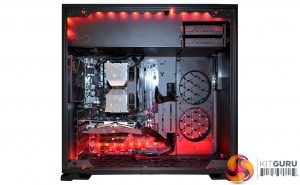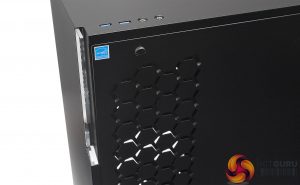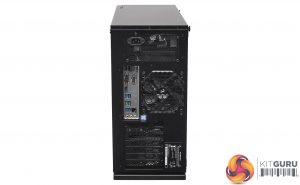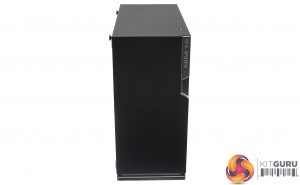Viglen has used a familiar InWin 101 case for this build – and there’s a lot to like. For starters, exterior build quality is beyond reproach: the metal used to build the side panels is sturdy, and the tempered glass side panel is similarly strong – and comes free with handy pop-out pins rather than screws.
This is a system that’ll withstand the rigours of the home, the office – or being lugged to LAN parties.
The InWin’s sturdy design is paired with understated looks. The front panel is made of plain metal and is only disturbed by the clear Perspex in one corner that holds the InWin logo and the power button. There isn’t any ornamentation on the roof, and the side panel is plain.
The Viglen’s subtle design is shared with the CyberPower Infinity X66 GTX, which used the same InWin case. Other machines are more outlandish, though: the PC Specialist Enigma Pro used the Corsair Carbide Spec-04, which has loads of red slashes across its black frontage, and the Overclockers UK Cobalt used a Phanteks Eclipse case that has an angled front panel and bright green lighting.
The InWin’s no-nonsense design gives way to an interesting interior. The In-Win case flips convention on its head by installing the power supply at the top of the chassis, with the motherboard positioned below.
The power supply is hidden beneath a sturdy metal shroud, and the 101’s two hard disk bays face outwards – so they’re easy to access. There’s only one spare, but it emerges smoothly on rails and has a tool-free installation method with sound-absorbing rubber washers.
The PSU’s position means that the bottom of the machine is free – and In-Win has covered this area with a honeycomb pattern and a long dust filter to improve airflow. There are three 120mm fan mounts here, and another two on the side panel can be used for more fans. Despite that, Viglen hasn’t installed any intake fans in this machine – so we’ll be intrigued to see how this rig handles our thermal tests.
The ATX motherboard stretches almost to the bottom of the case, but it’s still easy to get to the board and its components thanks to Viglen’s solid cable management. The main power cables are lashed together, and the smaller wires that attach to the bottom of the board are kept out of the way. All of the cables are discreetly routed through the 101’s various cut-outs. It’s neat around the back, too, and there’s room here for a couple of SSDs.
Viglen has upgraded the looks with a strip of red lights on the inside, which matches the lighting in the Perplex power button and the AMD components.
The red lighting lends the dark interior an attractive glow, but that’s it for extras. You don’t get a fan controller or lighting customisation on the machine itself. Build quality on the inside is sometimes a little iffy, too: the PCI blankers and the bottom panel and dust filter are both a little flimsy.
 KitGuru KitGuru.net – Tech News | Hardware News | Hardware Reviews | IOS | Mobile | Gaming | Graphics Cards
KitGuru KitGuru.net – Tech News | Hardware News | Hardware Reviews | IOS | Mobile | Gaming | Graphics Cards






